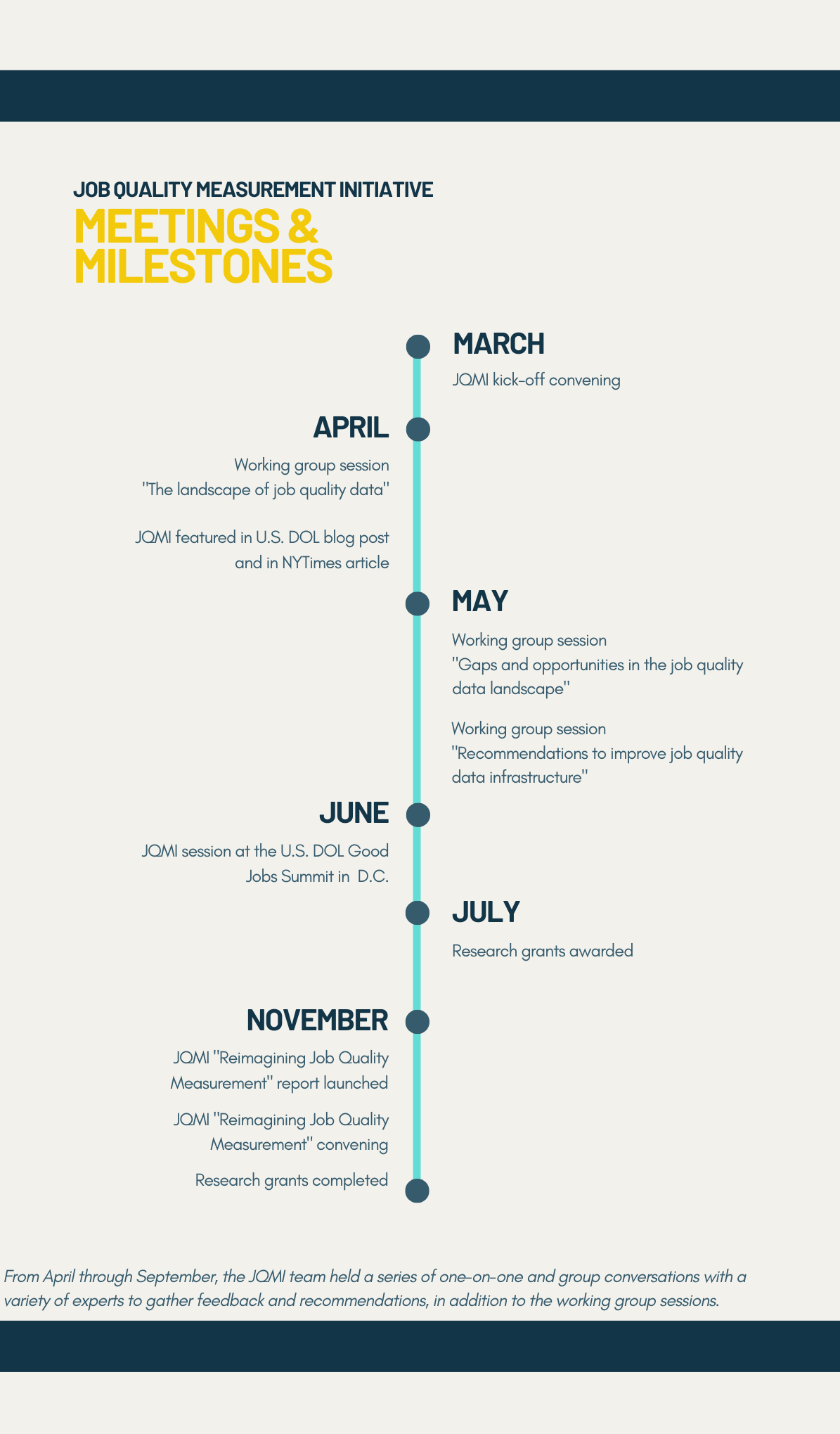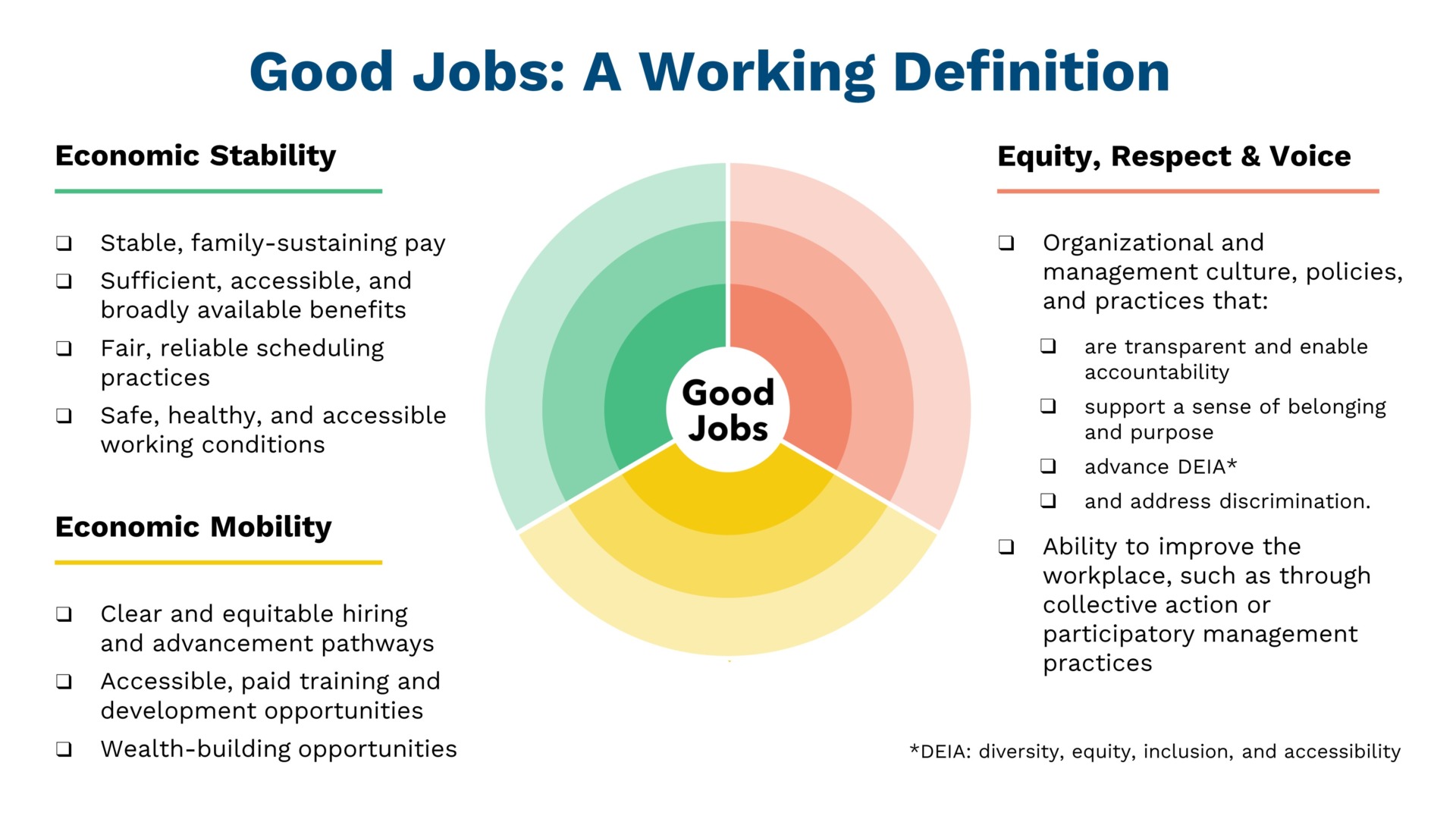Reimagining Job Quality Measurement
Table of Contents
Introduction
The 10 Big Ideas
Digging Deeper
- Measure what matters to workers, capturing a full range of job quality indicators
- Center equity in measurement
- Increase mandatory human capital data disclosure
- Link public and private data to gain new insights into the quality of jobs
- Leverage business data to demonstrate the return on investment from good jobs
- Revise data systems to include and support the non-W2 workforce
- Strengthen workforce system metrics to deliver results for workers and businesses
- Use public and private spending to measure and strengthen equity and good jobs
- Strengthen state and local capacity for data-driven decision-making to advance good jobs
- Invest in strengthening job quality measurement
Understanding the Impact
Appendices
Acknowledgements
Appendix 4: About the Job Quality Measurement Initiative
How We Structured the Job Quality Measurement Initiative
The Job Quality Measurement Initiative (JQMI) was launched in early 2022 by the Families and Workers Fund, Ford Foundation, Irvine Foundation, Lumina Foundation, Omidyar Network, and Schmidt Futures — in collaboration with the U.S. Department of Labor (DOL)—to better measure the quality of American jobs.
Through the spring and summer of 2022, the JQMI convened more than 70 leaders and data experts from across fields to analyze current measurement systems, identify gaps, and develop bold, actionable recommendations for government, philanthropy, business, and the nonprofit sector to collaborate toward improving job quality measurement.
A subset of 40 JQMI leaders with deep technical expertise in key datasets were asked to serve as working group members. The four working groups were organized by data category, as follows:
Administrative Data |
Federal and state program data, particularly state wage and workforce data (e.g., unemployment insurance wage records, Internal Revenue Service data). |
Federal Statistical Data |
Large-scale federal surveys and datasets such as data collected and disseminated by the U.S. Census Bureau and the U.S. Bureau of Labor Statistics. |
Performance Data |
Program performance data gathered from state and local agency grantees and public and private contractors as part of workforce programming and public procurement. |
Commercial/Employer Data: |
Private sector data gathered through online platforms, worker surveys, or other data collection efforts (e.g., Glassdoor, the Shift Project, Burning Glass, Indeed, LinkedIn, etc.) |
In addition, the JQMI engaged more than 30 advisors representative of core users of job quality data, including workforce development practitioners, investors and lenders, state government leaders, academic researchers, racial equity practitioners, and representatives of major commercial data platforms. Advisors provided guidance to the working groups, asked questions to help clarify assumptions, and worked to ensure that recommendations were responsive to practical needs and opportunities on the ground.
JQMI working groups and advisors surfaced bold, actionable ideas. For example, what if monthly federal government jobs reports expanded beyond unemployment statistics to include data on job quality? What if the public agencies that spend billions each year buying goods and services used data to ensure that their spending aligns with their goals to create and support good jobs and workforce equity? What if we created a standardized employer scorecard so that everyone from workers to investors and consumers could compare companies based on job quality and make data-informed choices about how they invest, what they buy, and where they work?
In the summer of 2022, following the completion of this first phase of work, eight teams of JQMI leaders were awarded small grants to conduct a 3-month research sprint to further develop select recommendations into tactical and technical next steps, and lay the foundation for demonstration projects to test and scale the most promising recommendations. A summary of these projects is included in Appendix 3.
Meetings & Milestones

Defining Good Jobs
The JQMI builds on work conducted by the Good Jobs Champions Group, convened by the Families and Workers Fund and the Aspen Institute Economic Opportunities Program, which brought together a coalition of leaders from business, labor, policy, philanthropy, and workforce development and solicited input directly from workers to develop and adopt a shared definition of job quality.
The Good Jobs Champions Statement1 provided a common starting place for members of the JQMI, who relied on the definition below to assess the existing data landscape and opportunities to strengthen it.

Not every job will meet every standard included in this definition; market forces may drive even well-meaning employers to focus on short-term cost containment rather than long-term value creation through workforce investment.
But members of the JQMI agreed that it is critical for business, government, labor, and nonprofits to together increase pathways towards good jobs, to increase the prevalence of good jobs, and to address the rampant disparities in access to and experiences within jobs based on race, gender, and other demographic characteristics.
Guiding Principles
Shared definitions, standards, and metrics for job quality can help to inspire new action, accelerate existing collaboration, and measure progress toward good jobs. However, data collection and evaluation is not values- or impact-neutral. JQMI working group members surfaced a set of shared values to shape data collection, linkage and analysis, reflected across this report:
Equity and Inclusion
Practices should be asset-based, acknowledge bias, and require disaggregation of data.
-
-
-
- Design metrics to shed light on inequities.
- Consider bias, including polarization, selection, and survey bias, in the design of data systems and make every effort to address it.
-
-
Privacy
Make protection of worker data and civil rights the building block for all measurement approaches.
-
-
-
- Prioritize privacy—along with the legal, ethical, and purposeful 2use of data—above increased access or facilitation of data linking.
- Require consent before data are used for purposes outside of the program or survey in which they were collected.
-
-
People-first
The voices and experiences of directly impacted people should drive development and implementation of measurement.
-
-
-
- Include workers in the design of measurement tools and the collection and evaluation of data to mitigate disparate impact.
- Ensure communities feel safe and heard by using trusted communicators and engagement strategies.
- Design measurement to create mutual benefit or incentives for all involved, honoring both business and worker contributions.
-
-
Burden reduction
Focus data collection on what is most meaningful; reduce or eliminate duplicative processes.
-
-
-
- Compensate and train service delivery organizations, and workers themselves, to carry out measurement work.
- Maximize use of existing data through linking before requiring additional data collection.
-
-
Endnotes
- The Families and Workers Fund and the Aspen Institute Economic Opportunities Program. A Shared Definition of Job Quality (2022).
- Actionable Intelligence for Social Policy, University of Pennsylvania. A Toolkit for Centering Racial Equity Throughout Data Integration.